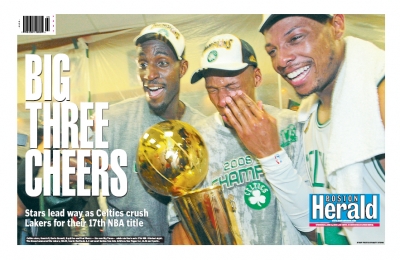The Baltimore Sun Media Group announced this morning that it will lay off 100 people out of its 1,400-person staff, with a disproportionate percentage of the cuts coming from the newsroom. The unit, which owns the Baltimore Sun and several community newspapers, told the Newspaper Guild that 55 to 60 jobs would be cut on the Sun‘s editorial staff, or about 20% of total newsroom employment. The paper will offer buyouts through July 18 and then use layoffs to meet its total job reduction goal.
The Hartfort Courant will cut 57 newsroom jobs, or nearly a quarter of its total editorial staff, along with a corresponding reduction in news pages. At its peak in 1994, the Courant employed 400 journalists. With the most recent cuts, that number falls to 175.
The focus on the editorial department is interesting in light of recent criticism by Tribune Co. executives of journalist productivity. CEO Sam Zell and COO Randy Michaels made it clear in a call with investors early this month that writers and editors would increasingly be measured by the quantity of their output. They said that most papers in the Tribune portfolio would lose pages and staff in the coming months and outlined plans for a series of redesigns that kicked off with a new look for the Orlando Sentinel this week.
Tribune Co. stands alone in its focus on cutting editorial staff. Most publishers have tried to limit newsroom layoffs out of concern about harming the quality of the product. Tribune Co. executives appear to have no such reservations. Zell and Co. are making a big bet that cuts in quality won’t significantly damage circulation, which is the key to advertising revenue. In a quote on Courant.com, Journalism Professor Rich Hanley of Quinnipiac University said of the shrinking Courant, “People could look at it and say, ‘This is nothing but a shopper on steroids.”
Here’s the memo from Sun Publisher Tim Ryan to employees:
The two key factors that will sustain our company for the future are customer satisfaction and financial stability. Achieving both goals is challenging in the very best of market conditions. In the face of today’s tough economy, adapting to consumer trends while maintaining our fiscal strength is proving to be even more difficult – yet even more critical.
Our long-term strategy of going on offense and creating growth opportunities will continue to get us closer to our goals. Already this year, we generated incremental Sun circulation gains, launched a new, free daily publication, b, which is the first of its kind in the market and, through our “explore” websites, delivered highly-localized news and information for the region’s consumers.
In spite of these early, significant wins, we struggled to achieve our performance goals. So, while we will stay on the offense, we are altering our game plan. In order to align ourselves more closely with our customers, we are retooling our business model, which will include enhancements to our newspaper. In August, 2008, The Sun redesign will debut, giving readers more of what they want – a more concise newspaper with more local news, personally relevant and useful content, consumer information, watchdog coverage, more graphics and better navigation.
By adjusting our business model and redesigning our core publication, we expect to stimulate readership growth and improve our financial performance. Regrettably, our new course also requires us to reduce our workforce by about 100 positions across BSMG. These actions are necessary for us to remain competitive and win in the future, and will enable us to create new targeted print and interactive media for the marketplace that satisfy both consumers and advertisers.
Transition Timeframe
The workforce reduction will include a combination of closing open positions, attrition, and voluntary and involuntary separation plans according to this timeline:
- Friday, June 27 – Voluntary separation packets will be available to all employees (availability to Guild-represented employees is being negotiated with the Guild). Volunteers will have two weeks, through Friday, July 11, to apply.
- Friday, July 11 – Thursday, July 17 – Volunteers will be notified whether their applications were accepted or not; decisions on involuntary separations will be made based upon voluntary results.
- Â Friday, July 18– Employees who are part of the involuntary separation plan will be notified. Voluntary and involuntary separations will occur in early August.
Human Resources, your leadership and plan documentation will provide further detail of plan terms, including compensation, savings/retirement funds and medical benefits. While Tribune does not have a formal severance policy, the formula that the company is using to determine benefits payable to employees affected by the current workforce reductions is more generous than any formula that the company may use after 2008.
Moving Forward
It is extremely difficult for all of us to lose colleagues and friends. However, while we cannot control the current economy, we can control what action we take to create a stronger future. We are, by far, Baltimore’s media leader, and through ongoing innovation to introduce new and exciting media for our marketplace, we will maintain our competitive position.
The leadership team and I will continue to keep you informed throughout this transition. Thank you for your patience, continuing contributions and commitment to our company
Tim
 Veteran journalist Ken Reich, a 39-year employee of the Los Angeles Times, died in his sleep last night. He posted his final entry on Take Back the Times just hours before he died. Reich retired from the Times four years ago and almost immediately began blogging. His blog was notable for its fine writing, its insight into the inner workings of the paper and its withering criticism of Tribune Co. management. Reich was a friend to executives and pressmen alike and his voice of loyal opposition will be missed.
Veteran journalist Ken Reich, a 39-year employee of the Los Angeles Times, died in his sleep last night. He posted his final entry on Take Back the Times just hours before he died. Reich retired from the Times four years ago and almost immediately began blogging. His blog was notable for its fine writing, its insight into the inner workings of the paper and its withering criticism of Tribune Co. management. Reich was a friend to executives and pressmen alike and his voice of loyal opposition will be missed. Tribune Co. CEO Sam Zell must be relieved to be back on familiar territory in the real estate business. He’s just put the neo-Gothic
Tribune Co. CEO Sam Zell must be relieved to be back on familiar territory in the real estate business. He’s just put the neo-Gothic 
 Could Rupert Murdoch save the US newspaper industry? He may have his chance sooner than anyone imagined because things are worse than anyone predicted
Could Rupert Murdoch save the US newspaper industry? He may have his chance sooner than anyone imagined because things are worse than anyone predicted


